
Viz Pilot User Guide
Version 7.2 | Published May 08, 2017 ©
Profile Configuration
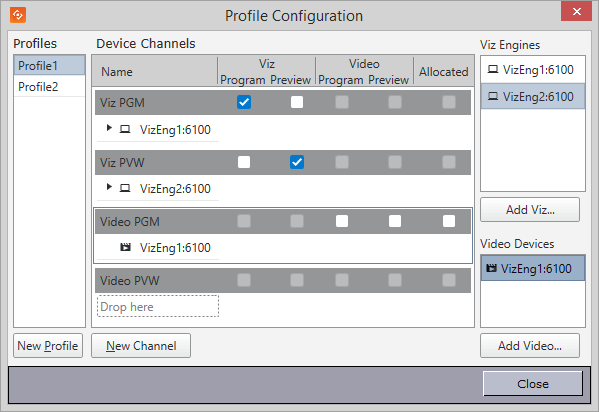
An important part of the profile configuration is to create profiles for different purposes. For example; Profile Setups can be created where different channels have the program and preview function. This makes it fast and easy to switch between different output settings.
This section contains the following topics
-
Categories and Channels
-
Profile Setups
-
Forked Execution
-
Configuring Profiles
-
Configuring Channels
-
Configuring Devices
Categories and Channels
To set the default channel for a template
A default channel can be set for a template.
-
In Template Wizard, add Categories and Channels.
-
Map the new category to the desired channel.
-
In Template Manager, edit a template variant and select the required Category from the drop-down list. See Working with Variants.
-
In Director, create a data element from the template and drag it to the playlist.
-
The default channel of the item is the channel selected in step 2.
Tip: The default channel can also be passed on to a newsroom system if required. See To get the data element’s default channel
Note: When setting categories and channels to filter playlists, the channel configuration configured in Template Manager must correspond with the actual channel name.
Note: Any Legacy template that does not use Control Object is unable to assign itself to the correct program channel; hence, it will always default to the default program channel in the profile configuration, and disregard information in the Categories and Channels setup.
-
Profile Setups
|
Profile |
Program |
Preview |
|
Main |
A |
B |
|
Backup |
B |
A typical example for when it makes sense to use different profiles would be a backup configuration where a switch from a main to a backup renderer is needed. For example if two output renderers are named A and B, where A is program and B is preview, a profile named “Main” will then have channel A as program and channel B as preview.
A profile named “Backup” could, if the renderer acting as program (A) in the “Main” profile fails, have channel B as program.
Note that a channel can be designated as a Program or Preview channel by selecting the check box in the appropriate columns (Program or Preview); however, the program and preview channels are reciprocally exclusive - only one channel can be set to program, and only one channel can be set to preview. If for example A is set to program and B is set to preview, and then C is set to program, A will no longer be set as program.
GPI
Another example of typical use of profiles is when playout is controlled through a General Purpose Input (GPI), for instance through hardware such as a vision mixer.
When GPI is enabled, the external cursor (the GPI system’s cursor) will be shown in any client that is using the same profile as the external system. A typical setup would be that one Viz Trio client is in the same profile as the GPI system, and functions as a “prepare station” for the producer sitting at the vision mixer desk. Data elements are then made ready and displayed on a preview visible to the producer, and then the elements are triggered from the vision mixer. This configuration needs a separate “GPI” profile that is not used by other control application clients. Other clients can be in other profiles and produce content to the same output channels. However, they need to be on other transition layers or on another Viz layer so that they will not interfere with the graphics controlled by the external system.
VDCP
If you are browsing the Cliplist for clips on other video devices (that support the Multiport Video Control Protocol (MVCP)) you may add these clips for manual playout in any playlist regardless of the profile configuration{.
Forked Execution
This section describes how forked execution can be used with Standalone scenes and Transition logic scenes. Forked Execution also replaces the execution of Visible containers.
Standalone scenes
Forked execution supports standalone scenes by executing the same graphics with different concepts on two or more render engines. Concepts are defined per channel when working with the Viz Pilot Configuration Tool.
As an option you can also use this setup to handle fail situations by having the same graphics concept rendered on both engines.
Transition logic scenes
As with Standalone scenes, forked execution supports setting concepts for Transition Logic scenes. In addition Transition Logic scenes, by defining channels with different render engine setups, can show different states of the same scene on a per engine basis. All states are synchronized for all engines (at all times) in order to achieve an artifact-free and smooth morphing of the graphics from one state to the other.
If for example you have three render engines you can set up a range of channels with different combinations of render engines per channel.
Channel and Engine Combinations
|
Channel |
Viz Engines |
|
A |
1,2,3 |
|
B |
1,3 |
|
C |
1 |
|
D |
2,3 |
|
E |
2 |
If for example you have a scene with four layers each layer can be controlled separately from the other layers (see table below). By setting a state per layer you can achieve a varied output depending on the channel used and how that channel is configured in terms of render engines (see table above).
-
Layer 1: Shows and hides a geometry (e.g. a cube)
-
Layer 2: Shows and hides a geometry (e.g. a cube)
-
Layer 3: Positions the geometries.
-
Layer 4. Animates the layer 1 geometry by showing the next image or a logo.
|
States for layer 1 |
States for layer 2 |
States for layer 3 |
States for layer 4 |
|
Show cube |
Show text |
Position left |
Next image |
|
Hide cube |
Hide text |
Position right |
Show logo |
|
<ignore> |
<ignore> |
Position center |
<ignore> |
|
|
|
<ignore> |
|
With the aforementioned scene layers and configured channels you can have the following output on each of the three engines.
|
Channel |
Layer state |
Output on Viz Engine 1, 2 and 3 |
|
Channel C(Viz 1) |
Show cubePos leftShow textShow logo |
|
|
Channel D(Viz 2,3) |
Show cubePos rightShow TextShow Logo |
|
|
Channel E(Viz 2) |
Pos centerHide text |
|
|
Channel A(Viz 1,2,3) |
Next image |
|
|
Channel A(Viz 1,2,3) |
Next image |
|
|
Channel A(Viz 1,2,3) |
Show textNext image |
|
|
Channel A(Viz 1,2,3) |
Show logo |
|
|
Channel B(Viz 1,3) |
Hide cube |
|
|
Channel E(Viz 2) |
Hide cube |
|
Visible containers
Director still supports (although it is deprecated), a behavior similar to that of forked execution. By designing a standalone scene where each root container is a variant of the other, you can configure each render engine To render specific scene containers (by name). In effect a scene with two or more root containers can have one or several containers assigned and rendered visible by one render engine.
Due to potential performance issues when using large textures (e.g. HD) this option is no longer recommended. Concept and variant design of standalone and transition logic scenes is therefore the recommended design convention.
Configuring Profiles
To open the profile configuration
-
Select Tools from the main menu, and then Profile Configuration (CTRL+M), or
-
Right-click the profile on the status bar (lower-left) and select Profile Configuration... from the context menu.
To add a new profile
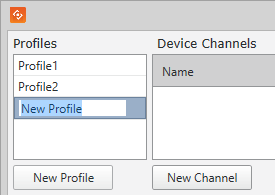
-
In the Profile Configuration window click the New Profile button, enter a new unique profile name, then press Enter.
To rename a profile
-
Right-click the profile and select Edit Profile Name, or double-click it and enter the new name.
-
When finished editing the name, press Enter or click the cursor outside the Profiles list.
To delete a profile
-
Right-click the profile and select Delete Profile, or select it and press the Delete button.
Note: The Media Sequencer requires a profile to be present in the system. If all profiles are deleted, an empty vizroom1 profile is automatically added.
Configuring Channels
This section contains the following topics:
-
To add an output channel to the Channels list
-
To add a concept override for a channel’s output device
-
To rename an output channel in the Channels list
-
To remove an output channel from the Channels list
-
To remove an output from the Channels list
To add an output channel to the Channels list

-
Click the New Channel button, or drag and drop a Viz Engine or video device to the Channels list.
To add a concept override for a channel’s output device

-
Expand the channel’s output device and append the concept name.
-
This will override any concepts set elsewhere
Caution: Concept names are case sensitive.
-
-
Click OK
To rename an output channel in the Channels list
-
Right-click the channel and select Edit Channel Name from the context menu, or double-click the name.
To remove an output channel from the Channels list

-
Right-click the channel entry and select Delete channel from the context menu, or select the channel and press the Delete button.
To remove an output from the Channels list
-
Right-click the Viz Engine or video device and select Delete Output, or simply select it and press Delete.
Allocated

-
Checking the Allocated check-box allocates video devices for the clips in the playlist. For two channels with a video device each, the Media Sequencer will enable transfer of all clips to all video devices. The clips in the playlist are, based on the allocation, played out in a given order (e.g. A, B, A, B) to allow back to back playout. For video devices that are able to playout back to back this allocation is not necessary.
Configuring Devices
This section contains the following topics:
-
To add a Viz Engine
-
To add a video device
-
To edit a Viz Engine or video device
-
To delete a Viz Engine or video device
-
To enable scene transitions
-
To enable still preview
-
To render specific scene containers
-
To set a different font encoding
To add a Viz Engine
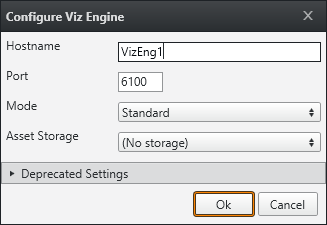
-
Click the Add Viz... button in the Profile Configuration window to open the Configure Viz Engine dialog box.
-
Enter the hostname and port (default port is 6100).
-
Optional: Select Mode
-
Scene Transitions: See how To enable scene transitions
-
Still Preview: See how To enable scene transitions
-
-
Optional: Select a Viz One storage (Asset Storage)
-
Optional: In Deprecated Settings, select Visible containers and/or Font Encoding
-
Click OK.
-
A status indicator will show if the renderer is on-air.
Note: The Asset Storage drop-down lists the available Viz Engine storage points where the Viz One files can be sent for playout.
-
To add a video device
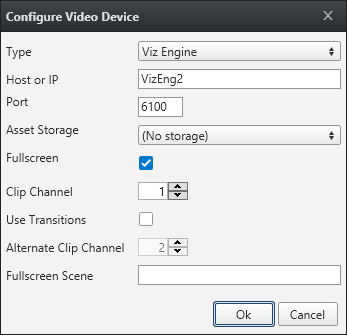
-
Click the Add Video... button in the Profile Configuration window to open the Configure Video Device dialog box.
-
Select the video server Type
-
Viz Engine
-
MVCP Compatible: Multiport Video Control Protocol, see Cliplist
-
Dummy Server: A dummy server can be part of a channel used for timing GFX in Timeline Editor. Used when it is necessary to adjust timing based on lowres clips.
-
-
Enter the Host or IP address and the port
-
Default port for MVCP is 5250
-
Default port for Viz Engine is 6100
-
-
Select Asset Storage. Select a publishing point from the list, so that clips or data elements are transferred to the right location (the specified Viz Engine) for playout
-
Enable/Disable Fullscreen mode
-
When Fullscreen is enabled, which is the default behavior, stand-alone video clip elements are played out full screen in the back layer. Graphics in the middle or front layer will still play.
-
When Fullscreen is disabled stand-alone video clip elements will only replace the current video clip without triggering animations or transition effects.
-
-
Select Clip Channel (only relevant for Viz Engine)
Note: Viz Engine 3.6 and later supports up to 16 clip channels which can be used for playout. A clip channel might be unavailable for various reasons, for example, it is configured to be inactive in Viz Config, or the license only covers a limited number of clip channels.
-
Select whether or not to Use Transitions
-
Select Alternate Clip Channel
-
Optional: Enter the Fullscreen Scene
-
Click OK.
-
A status indicator will show if the video device is on-air or online.
-
To edit a Viz Engine or video device
-
Right-click the device and select Edit from the context menu, or simply double-click it.
To delete a Viz Engine or video device
-
Right-click the device and select Delete from the context menu, or simply select it and press the Delete button.
To add an output to the Channels list
-
Simply drag and drop a Viz Engine or video device onto the channel in the Channels list, or select it and select Add to profile (creating a new channel) or Add to selected channel.
To enable scene transitions
Transition Effect scenes are made in Viz Artist and can be applied to data elements to create custom transition effects from one scene to the other. If an effect is specified, the effect will be shown when the scene is taken on-air. Effects are typically wipes, dissolves, alpha fades and so on.
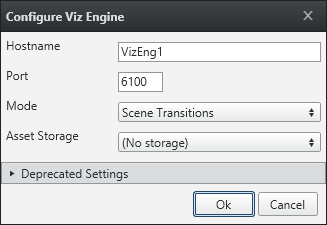
-
Configure the Viz Engine settings as seen in how To add a Viz Engine
-
Set the Mode to Scene Transitions to allow the renderer to copy (or snapshot) the scenes to create a transition effect between them.
-
Click OK
-
Add the program renderer to the program channel
Note: To see the effects the program channel must be configured and on-air.
To enable still preview
To render specific scene containers
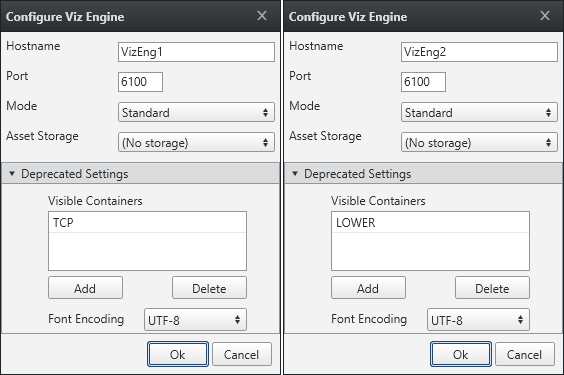
Before configuring your Viz Engines to render specific scene containers it is recommended to read the Forked Execution section for further explanation.
-
Configure the Viz Engine settings as seen in how To add a Viz Engine
-
Click the Deprecated settings button to expand the editor
-
Click the Add button to enter the scene’s container name that should be rendered visible
-
Optional: Repeat step 3 to Add other containers
-
Click Ok
To set a different font encoding
-
Configure the Viz Engine settings as seen in how To add a Viz Engine
-
Click the Deprecated settings button to expand the editor
-
Select the Font encoding
-
Font encoding: Sets the font encoding of the Viz Engine. The encoding can either be set to UTF-8 or ISO-8859-1. Default is UTF-8.
-
-
Click Ok.








